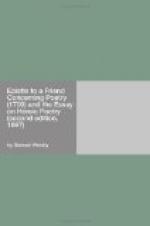of his Poem than any other of the Italians, whom yet
he justly blames, because he has two Hero’s
Godfredo and Rinaldo, of whom Godfredo seems the principal,
and yet Rinaldo performs the greatest part of the
notable Actions. He seems to imitate Agamemnon
and Achilles, but then he raises his Agamemnon too
high, or keeps him too low, for he hardly lets him
do one great Action through the whole Work. He
further criticises upon him as mingling too much Gallantry
with his Poem, which, he thinks, is unbecoming the
Gravity of his Subject. But whether this Censure
be just, I know not, for Love and Gallantry runs through
all Virgil’s AEneids, in the Instances of Helen,
Dido, and Lavinia, and indeed it gives so great a Life
to Epic, that it hardly can be agreeable without it,
and I question whether ever it has been so. Nor
is he more just, I think, against Tasso’s Episodes,
which he blames as not proper to circumstantiate his
principal Action, not entring into the Causes and
Effects thereof, but seeking too much to please, tho’
I think this Charge is unjust, for ’tis in his
Episodes, if any where, that Tasso is admirable.
I might here give several Instances, but shall, at
present, only refer my Reader to that of Tancred and
Erminia, and I’m mistaken if he does not dissent
from Rapin in this particular. Sannazarius and
Vida were the next who did any thing remarkable in
Epic; they both writ in Latin on the same Subject,
both Christian Heroics; Rapin says they both had a
good Genius for Latin, the Purity of their Style being
admirable, but that their ordering of the Fable has
nothing in’t of Delicacy, nor is the manner
of their Writing proportionable to the dignity of
the Subject. For Sannazarius he’s indeed
so faulty, that one can hardly with Patience read
him, the whole Structure of his imperfect Piece, de
partu, being built on Heathen Fable; yet he has great
and vigorous Thoughts and very Poetical Expressions,
tho’ therein Vida far excels him, whose Thoughts
are so noble, and the Air of his Stile so great, that
the Elogy Balzac gives his Countryman Tasso, wou’d
as well or rather better have fitted him; “That
Virgil is the Cause, Vida is not the first; and Vida,
that Virgil is not alone.” It is true, as
Rapin observes, that his Fable is very simple, and
perhaps so much the better, considering the Subject;
tho’ he forgets not Poetical Ornaments, where
there’s occasion, if he does not lean a little
to Sannazarius’s Error; for he talks of the
Gorgons and Sphinxes, the Centaurs and Hydra’s
and Chimera’s, though much more sparingly and
modestly than the other. He has the happiest beginning
that perhaps is to be found in any Poem, and by mingling
his Proposition and Invocation, has the advantage
of placing one of the noblest Thoughts in the World
in the first Line, without danger of falling into the
absurdity of Horace’s Author with his Fortunam
Priami: For thus he sings,
Qui mare, qui terras, qul coelum numine
comples
Spiritus alme, &c.




